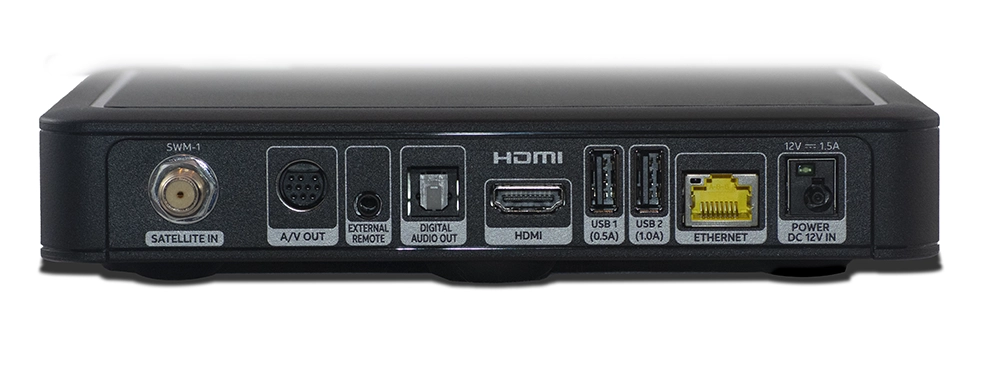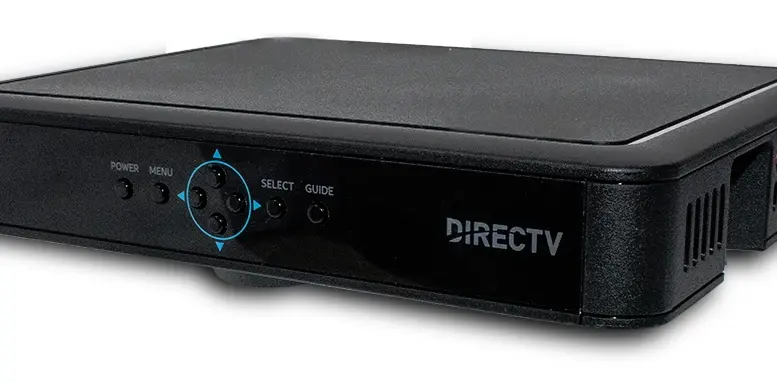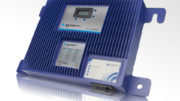What you see above you is DIRECTV’s newest H26K Commercial Receiver. Business customers are snapping it up as fast as DIRECTV can put them out there, and residential customers tell us they want a version of it for their RVs and boats, too. Why? As the first new traditional receiver from DIRECTV in over a decade, it brings a load of advanced features. For example:
- Watch SD, HD, or 4K without a DVR
- Use the popular Genie Remote, infrared, IR blaster, or IP control – your choice
- Control is easy with the free DIRECTV app for tablets (Apple and Google)
- Rack mount easily with this available shelf which holds 8 receivers
- Easy connection with built-in Ethernet port
- DIRECTV’s most modern interface including full control of power saver mode
Of course, there’s baked-in reliability too, since every H26K you’re likely to get today is going to be brand, spanking new. There’s only one thing this receiver won’t do that previous receivers did:
It won’t give you a component connection.

Despite having DIRECTV’s standard 10-pin connector on the back, this receiver will not output a component signal. (It still lets you connect a cable for a true standard-definition signal if you want.) This limitation has been confirmed, and is not likely to change.
In order to get an HD or 4K signal from the receiver you will need to use HDMI. And that means if your matrix switch isn’t capable of handling HDCP 2.2, you may run into problems using this receiver due to content protection being used on most channels.
Why is this happening?
The easiest explanation is that most people don’t need a component connection. Today’s TVs rarely include component inputs. If you look at other media players like streaming boxes and physical disc players, you’ll see they gave up component long ago. The choice to abandon component connections in this receiver (and also in other DIRECTV 4K-capable hardware) was made as a tradeoff. It avoids engineering challenges inherent in providing 4K content. Component connections can’t handle 4K, and a system that allowed both component and 4K would have to know that you weren’t using HDMI at all. It would then have to disable 4K output. Obviously this sort of thing isn’t impossible, but it’s hard with a passive connection like component, and I tend to think it wasn’t worth the engineering time.
Is this evidence of a conspiracy?
There’s an urban legend that every single maker of home theater equipment struck an unholy deal in the 2000s to do away with component connections. The story goes that they were facing pressure from movie studios, who knew that component connections would easily defeat copy protection on their physical discs. So, the legend goes, if you wanted to use the new HDMI standard, you would have to phase out component connections on your new hardware by some specific date. The legend tends to quote 2012 or something like that. Using the date 2012 tied it into the Mayan calendar, which is essentially catnip to conspiracy theorists.
Like all conspiracy theories, this one has a nugget of truth to it. It’s true that studios and manufacturers were talking in the early 21st century about closing the so-called “analog hole” that let customers get unencrypted HD using component connections. According to this site, an agreement was reached where major Blu-ray disc manufacturers would stop making devices with component connections after 2013. Here’s an excerpt from that page:
Analog Sunset refers to the Advanced Access Content System (AACS) license agreement adopted by content owners and device manufacturers to protect material recorded on Blu-ray Disc® media from being copied illegally.
The license agreement requires Blu-ray Disc players manufactured after December 31, 2010 to limit the resolution output through a component video cable to standard definition, 480i or 576i. Additionally, since January 1, 2011, the producers of Blu-ray Disc media can include an Image Constraint Token on the disc that prevents a high definition signal from being output through component video on a Blu-ray Disc player manufactured before the aforementioned date. After December 31, 2013, Blu-ray Disc players with component video output jacks will no longer be sold.
However, this agreement never applied to set-top boxes, satellite TV decoders, streaming devices, or the like. It only applied to Blu-ray disc players, which were thought of as the only way you could get HD content at the time.
So why did component video disappear?
Component video disappeared from consumer electronics within the last decade. Why? Because people don’t want it. It won’t carry 4K. It won’t do HDR. Trying to get anything but stereo audio using RCA connections can be a real hassle. The truth is, even with all its problems, HDMI is a much better solution in almost every case. Yes, HDMI carries content protection. But, most people won’t have to worry about it.
And I get it, business customers aren’t “most people.” If you’re trying to integrate your H26K into an existing system with matrix switches, you might find it a challenge. But this isn’t the first time you’ve had to do system upgrades and it won’t be the last. There are many current matrix switches that support the latest HDMI standards as well as IP control. When you upgrade to one, you’ll find it’s a better solution overall.
Yeah but what if you want a component connection?
You have two options, and they’re both good. You can choose DIRECTV’s H25, which is still available through Solid Signal.

With the H26K now available, it’s freed up the limited supply of DIRECTV H25 receivers. These have proven to be incredibly reliable and many are still out in the field doing great work. If you need a component connection, you can use one with ZeeVee’s hydra cable to get the connection you need.
You can also use an inexpensive HDMI to component converter like this one. While it’s not guaranteed to work in every case (for example, it still won’t do 4K) it will generally give you the connection you need.
If you have more questions, contact the experts! The folks at Signal Connect are DIRECTV Commercial dealers, in fact we were awarded DIRECTV’s Commercial Dealer of the Year! We know just what you need to keep your business running and we’ll give you all the options. Just call us at 888-233-7563 or fill out the form below.





